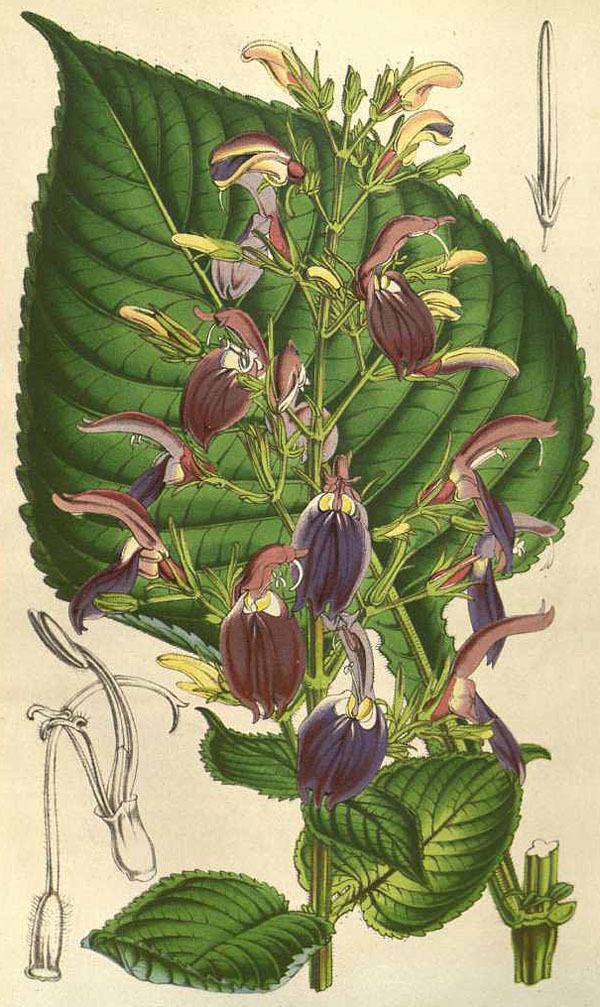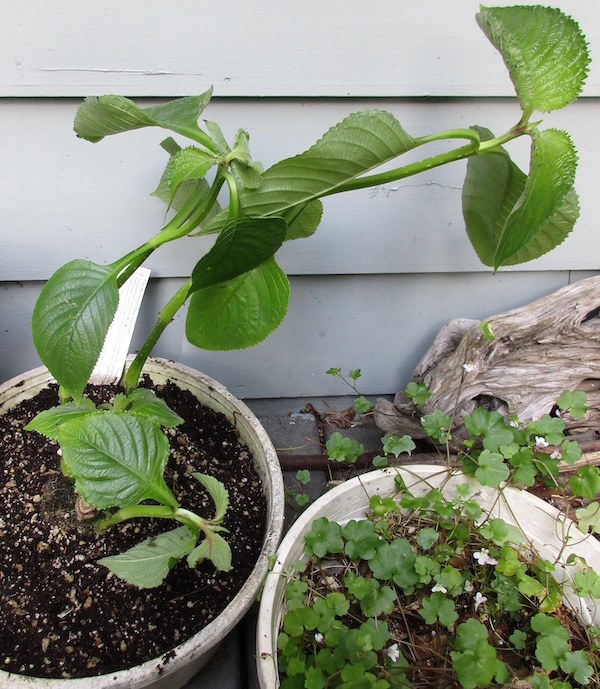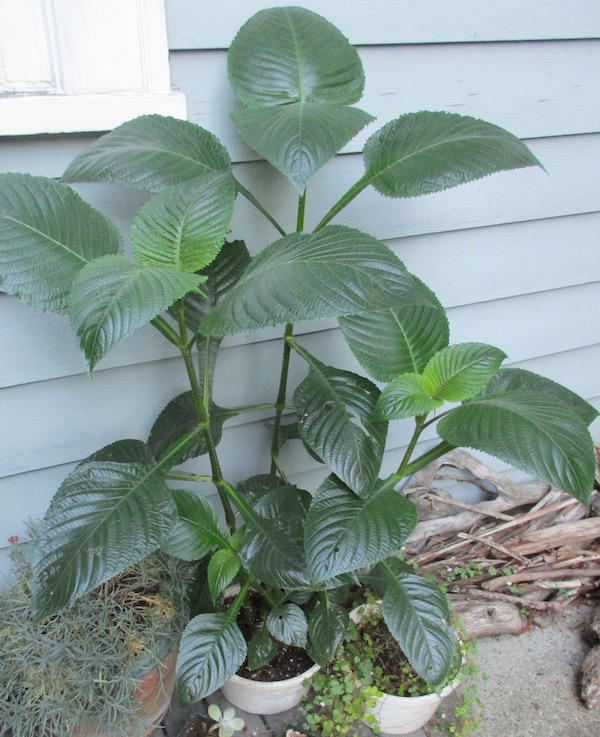| A bold looking, large tropical perennial that resembles a Salvia superficially, is my feature this month. I bought a small specimen from Almost Eden nursery of Louisiana, in mid-June; it is now relatively gigantic at 3.5 feet tall but has not yet flowered. I must take it indoors to overwinter it. For foliage alone, it is my most striking potted plant. Comapre my June 29th & September 28th photos below. Reading about this Brillantaisia, I learned that it is confused with one or two other species, so therefore in this article I try to set the matter straight. Books, websites and nurseries employ varying and often contradictory names, and I have not seen Karen J. Sidwell's obscure 1998 Brillantaisia monograph, so remain in doubt. |
| Genus Brillantaisia has about 13 species, all of Africa or Madegascar. A very close cousin is genus Hygrophila. |
The three species I cite below, all African and frost-tender, are sometimes potted and overwintered indoors in the frigid North, or grown in greenhouses. They are similar enough and rare enough in cultivation to get confused much. The plant that I bought, under the name Brillantaisia owariensis may or may not be named accurately, but I am guessing it is correct.
|
| Brillantaisia cicatricosa Lindau |
| = B. ulugurica Lindau |
| = B. subulugurica Burk. |
| = B. grandidentata S. Moore |
| Tropical Giant Salvia or Sage |
| A soft-wooded aromatic shrub or even a small tree, to 16 feet tall. Leaves dramatic in size, to 15 and three-forths by 9.5 inches; stem winged broadly; toothed coarsely with small and large teeth. Flowers in open, branched clusters. Flowers 1 to 1.5 (2 inches) long, pale to bright blue, mauve, violet or purple. Seedpod 1 to 1.5 inches long, glandular-hairy. Seeds 3 - 4 mm. |
Unlike the next two species, not reported edible. It is a glorious foliage plant though requires much space.
|
| Brillantaisia Lamium (Nees) Benth. |
| = B. Eminii Lindau |
| A perennial 4 to 5 (6 feet) tall, creeping & rooting, then erect. Leaves to 6 and three-forths by 4 inches; stem unwinged; untoothed to toothed coarsely. Floral tube whitish; lower lip blue to dark blue or purple to dark brillant purple; upper lip greenish tinged bluish to dark purple; 1 - 2+ inches long. Seedpod 1 to 1 and three-forths inches long. Seeds 1.5 - 2 mm. |
This species is smallest, with unremarkable foliage but relatively showy flowers. According to the 1999 Report on the Ethnobotany of the Nyindu in the Eastern Part of the Former Zaire (African Study Monographs 20(1): 1 - 72) the flowers are sweet, and eaten by children.
|
| Brillantaisia owariensis P. Beauv. |
| = B. nitens Lindau |
| Tropical Giant Salvia or Sage |
| Tropical Africa in moist lowland to submontane forests, often along streams or in damp places. An exuberant perennial 6 to 9 (13 feet) tall, erect. Leaves to 11 by 8 inches; stem winged; toothed. Flowers pale to deep mauve, pale to deep purple or blue to dark blue with white throats; 1 - 2 inches long. Seedpod (two-thirds) three-forths to one and one third inches long. Seeds more or less 1.5 mm. |
| This is I believe what I show in the images below. It is variable; the degree of water, warmth and fertility it grows in, affects its size. But to judge from what I read, and observe in my specimen, even if it made no flowers, it stands arresting visually due to: its rampant growth; remarkable dark green leaves with their impressive "arrowhead" flanges; and the bone-like swollen square stems. |
| In Southern Nigeria, the Igbo people use it in soups, as reported in The Igbo traditional food system documented in four states in southern Nigeria by Elizabeth C. Okeke et al. 2009 pp. 251 - 281 in Indigenous Peoples' food systems: the many dimensions of culture, diversity and environment for nutrition and health. Other reports also exist of Africans consuming the plant. |
In Uganda, Chimpanzees eat the flowers, pith and roots. I find that the raw leaves taste bland, recalling Lamium species or hazelnuts.
Back |

Brillantaisia owariensis ; drawing from; Flore des Serres et des Jardin de l'Europe by L. van Houtte, vol. 9: p. 116, t. 901 (1853)
|

Brillantaisia owariensis ; June 29th in Seattle ; photo by ALJ
|

Brillantaisia owariensis ; September 28th in Seattle ; photo by ALJ
|

